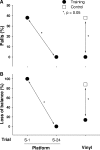Generalization of gait adaptation for fall prevention: from moveable platform to slippery floor
- PMID: 19073804
- PMCID: PMC2657073
- DOI: 10.1152/jn.91004.2008
Generalization of gait adaptation for fall prevention: from moveable platform to slippery floor
Abstract
A person's ability to transfer the acquired improvements in the control of center of mass (COM) state stability to slips induced in everyday conditions can have profound theoretical and practical implications for fall prevention. This study investigated the extent to which such generalization could take place. A training group (n=8) initially experienced 24 right-side slips in blocked-and-random order (from the 1st unannounced, novel slip, S-1 to the last, S-24) resulting from release of a low-friction moveable platform in walking. They then experienced a single unannounced slip while walking on an oil-lubricated vinyl floor surface (V-T). A control group (n=8) received only one unannounced slip on the same slippery floor (V-C). Results demonstrated that the incidence of balance loss and fall on V-T was comparable to that on S-24. In both trials, fall and balance-loss incidence was significantly reduced in comparison with that on S-1 or on V-C, resulting from significant improvements in the COM state stability. The observed generalization indicates that the control of COM stability can be optimally acquired to accommodate alterations in environmental constraints, and it may be broadly coded and easily modifiable within the CNS. Because of such mechanisms, it is possible that the locomotor-balance skills acquired with the aid of low-friction moveable platforms can translate into resisting falls encountered in daily living.
Figures





References
-
- Abeele S, Bock O. Transfer of sensorimotor adaptation between different movement categories. Exp Brain Res 148: 128–132, 2003. - PubMed
-
- Adkin AL, Frank JS, Carpenter MG, Peysar GW. Fear of falling modifies anticipatory postural control. Exp Brain Res 143: 160–170, 2002. - PubMed
-
- Andres RO, Eng T, O′Connor D. Sagittal plane kinematics of walking onto a slippery surface and gait adaptations from continuous walking on slippery surfaces. The Slipping, Tripping, and Falling Accident Conference, London, 1991.
-
- Beling J, Wolfe GA, Allen KA, Boyle JM. Lower extremity preference during gross and fine motor skills performed in sitting and standing postures.[see comment]. J Orthopaed Sports Phys Ther 28: 400–404, 1998. - PubMed
MeSH terms
LinkOut - more resources
Full Text Sources
Medical

